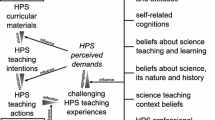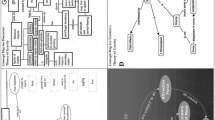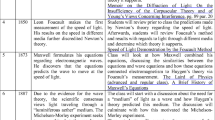Abstract
This study investigates whether graduate courses for in-service physics teacher professional development that combine the conceptual history of physics, physics content, and physics education research readings will result in the teachers using the history of science for their own classroom instruction. In a study conducted in the USA, teachers who took such courses reported that their instruction in the history of science resulted in their better understanding of student learning, and a better ability to include the history of physics in their teaching. Ten teachers were selected from the pool of teachers who had participated in the professional development to determine how the self-reported use of the history of science translated into the teachers’ classroom practice. The research questions addressed whether or not the teachers used the history of science in their practice, and if so, how and what obstacles the teachers perceived in using the history of science. The investigation found that all ten teachers used the history of science in their physics classes to better understand their students’ conceptions in physics, to teach about theory change, and to increase student interest. Eight also used history to better communicate physics concepts. All discussed impediments they perceive to more use of history with their students. The professional development described may serve as a model for changing science teachers’ practice with respect to teaching with the history of science.





Similar content being viewed by others
Data Availability
Data will be shared to the extent possible, based on IRB guidance, upon request.
Code Availability
Not applicable.
References
Abd-El-Khalick, F., Bell, R. L., & Lederman, N. G. (1998). The nature of science and instructional practice: Making the unnatural natural. Science education, 82(4), 417–436.
Abd-El-Khalick, F., & Lederman, N. G. (2000a). Improving science teachers’ conceptions of nature of science: A critical review of the literature. International journal of science education, 22(7), 665–701.
Abd-El-Khalick, F., & Lederman, N. G. (2000b). The influence of history of science courses on students’ views of nature of science. Journal of Research in Science Teaching, 37(10), 1057–1095.
Adamson, S. L., Banks, D., Burtch, M., Cox, F., Judson, E., Turley, J. B., & Lawson, A. E. (2003). Reformed undergraduate instruction and its subsequent impact on secondary school teaching practice and student achievement. Journal of Research in Science Teaching, 40(10), 939–957.
Ahlgren, A., & Walberg, H. J. (1973). Changing attitudes towards science among adolescents. Nature, 245(5422), 187–190.
Allchin, D. (2000). How not to teach historical cases in science. Journal of College Science Teaching, 30(1), 33–37.
Allchin, D. (2012). The Minnesota case study collection: New historical inquiry case studies for nature of science education. Science & Education, 21(9), 1263–1281.
American Association for the Advancement of Science (AAAS). (1990). Science for all Americans. Oxford University Press.
Bell, R. L., Lederman, N. G., & Abd-El-Khalick, F. (2000). Developing and acting upon one’s conception of the nature of science: A follow-up study. Journal of research in science teaching, 37(6), 563–581.
Clement, J. (1982). Students’ preconceptions in introductory mechanics. American Journal of Physics, 50(1), 66–71.
Clough, M. P. (2011). The story behind the science: Bringing science and scientists to life in post-secondary science education. Science & Education, 20(7–8), 701–717.
Cofré, H. (2012). La enseñanza de la naturaleza de la ciencia en Chile: del currículo a la sala de clases [Teaching nature of science in Chile: From the curriculum tothe classroom]. Chilean Review of Scientific Education, 11, 12–21.
Collins, A., & Ferguson, W. (1993). Epistemic forms and epistemic games: Structures and strategies to guide inquiry. Educational psychologist, 28(1), 25–42.
Conant, J. B. (1947). On understanding science an historical approach. Yale University Press.
Conant, J. B., & Nash, L. K. (Eds.). (1957). Harvard case histories in experimental science. Harvard University Press.
Darling-Hammond, L., Hyler, M. E., Gardner, M. (2017). Effective teacher professional development. Palo Alto, CA: Learning Policy Institute. https://learningpolicyinstitute.org/product/teacher-prof-dev, Accessed 14 June 2020.
Desimone, L. M., Porter, A. C., Garet, M. S., Yoon, K. S., & Birman, B. F. (2002). Effects of professional development on teachers’ instruction: Results from a three-year longitudinal study. Educational evaluation and policy analysis, 24(2), 81–112.
Desimone, L. M. (2009). Improving impact studies of teachers’ professional development: Toward better conceptualizations and measures. Educational Researcher. https://doi.org/10.3102/0013189X08331140.
Disessa, A. (1983). Phenomenology and the evolution of intuition In D. Gentner & A. Stevens (Eds.), Mental Models.
Eliot, C. W. (1869). The new education. Atlantic monthly, 23(2), 203–220. https://www.theatlantic.com/magazine/archive/1869/02/the-new-education/309049/, Accessed 7 July 2020.
Etkina, E. (2010). Pedagogical content knowledge and preparation of high school physics teachers. Physical Review Special Topics-Physics Education Research, 6(2), 020110.
Franklin, B., & Cohen, I. B. (1941). Benjamin Franklin’s experiments: A new edition of Franklin’s experiments and observations on electricity (Vol. 27). Harvard University Press.
Galili, I. (2008). The history of physics as a tool of teaching. In M. Vicentini & E. Sassi (Eds.), Connecting research in physics education with teachers education (pp. 1–11). International Commission on Physics Education. http://web.phys.ksu.edu/icpe/Publications/teach2/Galili.pdf, Accessed 15 February 2013.
Galili, I., & Hazan, A. (2000). The influence of an historically oriented course on students’ content knowledge in optics evaluated by means of facets-schemes analysis. American Journal of Physics, 68(S1), S3–S15.
Galili, I., & Hazan, A. (2001). The effect of a history-based course in optics on students’ views about science. Science & Education, 10(1–2), 7–32.
Garik, P., & Benétreau-Dupin, Y. (2014). Report on a Boston University conference December 7–8, 2012 on how can the history and philosophy of science contribute to contemporary US science teaching? Science & Education, 23(9), 1853–1873.
Garik, P., Duffy, A., Eisenkraft, A., Faux, R., Garbayo, L., Sikorski, T., Voroshilov, V., & Winrich, C. (2007). Improving the teaching of physics: Professional development for teachers changing content fields. Paper presented at the Annual Meeting of the National Association for Research in Science Teaching. New Orleans, LA.
Garik, P., Garbayo, L., Benétreau-Dupin, Y., Winrich, C., Duffy, A., Gross, N., & Jariwala, M. (2015). Teaching the conceptual history of physics to physics teachers. Science & Education, 24(4), 387–408.
Ha, S., Lee, G., & Kalman, C. S. (2013). Workshop on friction: Understanding and addressing students’ difficulties in learning science through a hermeneutical perspective. Science & Education, 22(6), 1423–1441.
Halloun, I. A., & Hestenes, D. (1985). Common sense concepts about motion. American Journal of Physics, 53, 1056–1065.
Hammer, D. (2000). Student resources for learning introductory physics. American Journal of Physics, 68(S1), S52–S59.
Hatch, R. A. (2002). History of science classroom lesson plans. http://users.clas.ufl.edu/ufhatch/pages/05-SecondaryTeaching/NSF-PLANS/contents.html, Accessed 23 July 2016.
Henke, A., & Höttecke, D. (2015). Physics teachers’ challenges in using history and philosophy of science in teaching. Science & Education, 24(4), 349–385.
HIPST Website. (n.d.) http://hipstwiki.wikifoundry.com/page/hipst+developed+cases/, Accessed 31 May 2020.
Holton, G. (1978). The scientific imagination. Cambridge University Press.
Holton, G. (2003). The project physics course, then and now. Science & Education, 12(8), 779–786.
Höttecke, D. (2012). HIPST: History and philosophy in science teaching: a European project. Science & Education, 21(9), 1229–1232.
Höttecke, D., Henke, A., & Riess, F. (2012). Implementing history and philosophy in science teaching: Strategies, methods, results and experiences from the European HIPST project. Science & Education, 21(9), 1233–1261.
Höttecke, D., & Silva, C. C. (2011). Why implementing history and philosophy in school science education is a challenge: An analysis of obstacles. Science & Education, 20(3–4), 293–316.
Howe, E. M., & Rudge, D. W. (2005). Recapitulating the history of sickle-cell anemia research. Science & Education, 14(3), 423–441.
Kalman, C. S. (2002). Developing critical thinking in undergraduate courses: A philosophical approach. Science & Education, 11(1), 83–94.
Kalman, C. (2010). Enabling students to develop a scientific mindset. Science & Education, 19(2), 147–163.
Kipnis, N. (1996). The ‘historical-investigative’approach to teaching science. Science & Education, 5(3), 277–292.
Klopfer, L. E. (1969). The teaching of science and the history of science. Journal of research in science teaching, 6(1), 87–95.
Klopfer, L. E., & Cooley, W. W. (1963). The history of science cases for high schools in the development of student understanding of science and scientists: A report on the HOSC instruction project. Journal of Research in Science Teaching, 1(1), 33–47.
Koselleck, R. (2002). The practice of conceptual history: Timing history, spacing concepts (T. S. Presner, Trans.). Stanford: Stanford University Press.
Kuhn, T. S. (1970). The structure of scientific revolutions. University of Chicago Press.
Lawrenz, F., & Kipnis, N. (1990). Hands-on history of physics. Journal of Science Teacher Education, 1(3), 54–59.
Lawson, A. E., Benford, R., Bloom, I., Carlson, M. P., Falconer, K., Hestenes, D., et al. (2002). Evaluating college science and mathematics instruction. Journal of College Science Teaching., 31(6), 388–393.
Lederman, N. G., Abd-El-Khalick, F., Bell, R. L., & Schwartz, R. S. (2002). Views of nature of science questionnaire: Toward valid and meaningful assessment of learners’ conceptions of nature of science. Journal of research in science teaching, 39(6), 497–521.
Loucks-Horsley, S., Stiles, K. E., Mundry, S., Love, N., Hewson, P. W. (2009). Designing professional development for teachers of science and mathematics. Corwin press
Massachusetts Department of Elementary and Secondary Education. (n.d.). School/District Profiles Search. http://profiles.doe.mass.edu/search/search.aspx, Accessed 13 July 2012
Matthews, M. R. (1994). Science teaching: The role of history and philosophy of science. Routledge.
Matthews, M. R. (2015). Science teaching: The contribution of history and philosophy of science. Routledge.
McComas, W. (2014) “Nature of science in the science curriculum and teacher education in the United States” in Matthews, M. R. (Ed.) (2014). International handbook of research in history, philosophy and science teaching. Springer
McComas, W. F., & Kampourakis, K. (2015). Using the history of biology, chemistry, geology, and physics to illustrate general aspects of nature of science. Review of Science, Mathematics and ICT education, 9(1), 47–76.
McDermott, L. C., Rosenquist, M. L., & van Zee, E. H. (1987). Student difficulties in connecting graphs and physics: Examples from kinematics. American Journal of Physics, 55(6), 503–513.
McDermott, L. C., Shaffer, P. S., & Somers, M. D. (1994). Research as a guide for teaching introductory mechanics: An illustration in the context of the Atwood’s Machine. American Journal of Physics, 62(1), 46–55.
Monk, M., & Osborne, J. (1997). Placing the history and philosophy of science on the curriculum: A model for the development of pedagogy. Science education, 81(4), 405–424.
Morse, R. A. (Ed.) (2004). Benjamin Franklin: Papers on electricity. http://www.compadre.org/psrc/franklin/. Accessed 31 May 2020.
National Curriculum Board. (2009). The shape of the Australian curriculum. Retrieved from https://docs.acara.edu.au/resources/The_Shape_of_the_Australian_Curriculum_May_2009_file.pdf.
National Research Council. (2012). A framework for K-12 science education: Practices, crosscutting concepts, and core ideas. National Academy Press.
Niaz, M. (2009). Progressive transitions in chemistry teachers’ understanding of nature of science based on historical controversies. Science & Education, 18(1), 43–65.
Olson, J. K. (2018). The inclusion of the nature of science in nine recent international science education standards documents. Science & Education, 27(7–8), 637–660.
Patton, M. Q. (2002). Qualitative research and evaluation methods. (3rd ed.). Sage Publications.
Pavez, J. M., Vergara, C. A., Santibañez, D., & Cofré, H. (2016). Using a professional development program for enhancing Chilean biology teachers’ understanding of nature of science (NOS) and their perceptions about using history of science to teach NOS. Science & Education, 25(3–4), 383–405.
Posner, G. J., Strike, K. A., Hewson, P. W., & Gertzog, W. A. (1982). Accommodation of a scientific conception: Toward a theory of conceptual change. Science education, 66(2), 211–227.
Rhodes, R. (1986). The making of the atomic bomb. Simon & Schuster.
Roach, L. E., & Wandersee, J. H. (1993). Short story science. The Science Teacher, 60(6), 18.
Roach, L. E., & Wandersee, J. H. (1995). Putting people back into science: Using historical vignettes. School Science and Mathematics. https://doi.org/10.1111/j.1949-8594.1995.tb15802.x.
Rosenquist, M. L., & McDermott, L. C. (1987). A conceptual approach to teaching kinematics. American Journal of Physics, 55(5), 407–415.
Rudge, D., & Howe, E. (2004). Incorporating history into the science classroom. The Science Teacher, 71(9), 52–57.
Rudge, D. W., & Howe, E. M. (2009). An explicit and reflective approach to the use of history to promote understanding of the nature of science. Science & education, 18(5), 561–580.
Rudge, D. W., Cassidy, D. P., Fulford, J. M., & Howe, E. M. (2014). Changes observed in views of nature of science during a historically based unit. Science & Education, 23(9), 1879–1909.
Rutherford, F.J., Holton, G., & Watson, F.G. (1981). Project Physics. Project Physics Collection, on archive.org. http://archive.org/details/projectphysicscollection. Accessed 3 August 2013.
Rutt, A., & Mumba, F. (2019). Developing preservice teachers’ understanding of and pedagogical content knowledge for history of science–Integrated science instruction. Science & Education, 28(9–10), 1153–1179.
Sandwell, R. (2005). School history versus the historians. International Journal of Social Education, 20(1), 9–17.
Seroglou, F., & Koumaras, P. (2001). The contribution of the history of physics in physics education: A review Science & Education. https://doi.org/10.1023/A:1008702000098.
Shamos, M. (1959). Great experiments in physics: Firsthand accounts from Galileo to Einstein. Holt, Rinehart, and Winston.
SHiPS (n.d.). Retrieved from http://shipseducation.net/modules/index.htm, Accessed 31 May 2020
Teixeira, E. S., Greca, I. M., & Freire, O. (2009). The history and philosophy of science in physics teaching: A research synthesis of didactic interventions. Science & Education. https://doi.org/10.1007/s11191-009-9217-3.
The story behind the science (n.d.) https://www.storybehindthescience.org/index.html, Accessed 31 May, 2020.
Toulmin, S., & Goodfield, J. (1962). The fabric of the heavens: The development of astronomy and dynamics. Harper.
Trowbridge, D. E., & McDermott, L. C. (1980). Investigation of student understanding of the concept of velocity in one dimension. American Journal of Physics, 48(12), 1020–1028.
VanSledright, B. (2011). The challenge of rethinking history education: On practices, theories, and policy. Routledge.
Wandersee, J. H. (1992). The historicality of cognition: Implications for science education research. Journal of Research in Science Teaching, 29(4), 423–434.
Welch, W. W. (1973). Review of the research and evaluation program of Harvard Project Physics. Journal of Research in Science Teaching, 10(4), 365–378.
Welch, W. W., & Walberg, H. J. (1972). A national experiment in curriculum evaluation. American Educational Research Journal, 9(3), 373–383.
Winrich, C., Duffy, A., Eisenkraft, A, Faux, R., Garbayo, L., & Garik, P. (2008). The impact of teaching the conceptual history of physics as a sequence of models on the understanding of the nature of science by physics Teachers. In Conference proceedings of the 2008 annual international conference of the national association for research in science teaching. Baltimore, MD.
Winrich, C., Garik, P., Nolan, M.D., Eisenkraft, A., Duffy, A., Jariwala, M., Garabayo, L., & Gross, N. (2010). Teaching the Conceptual History of Physics to Teachers. Paper presented at the annual meeting of the national association for research in science teaching. Philadelphia, PA.
Winrich, C., Garik, P., Nolan, M. D., Benétreau-Dupin, Y., Duffy, A., Eisenkraft, A., Garabayo, L., Gross, N., Jariwala, M., & Faux, R. (2011). Using physics education research literature in teacher professional development. In Conference proceedings of the 2008 annual international conference of the national association for research in science teaching. Orlando, FL.
Acknowledgements
We thank Yann Benétreau-Dupin for his comments on an early version of this work. We also thank the developers and instructors of the Improving the Teaching of Physics courses: Luciana Garbayo, Andrew Duffy, Tiffany Sikorsky, Manher Jariwala, Nicholas Gross, and Yann Benétreau-Dupin. We are also grateful to Bruce Fraser for his methodological guidance in conducting this study, and Christine Baron for her assistance in data analysis.
Funding
Support for the Improving Teaching of Physics project was provided from 2005 to 2010 by the Commonwealth of the State of Massachusetts (Grant CTRGT5NCLBBU200000000000) and the Massachusetts Regents (Grant CTRGTFY08BOSTONUNIVITQ08).
Author information
Authors and Affiliations
Corresponding author
Ethics declarations
Informed Consent
In accordance with Institutional Review Board (IRB) procedures, informed consent for participation was obtained from each teacher who participated in this study, and from the principal of each school the researcher visited.
Conflict of Interest
The authors declare that they have no conflict of interest.
Additional information
Publisher’s Note
Springer Nature remains neutral with regard to jurisdictional claims in published maps and institutional affiliations.
Rights and permissions
About this article
Cite this article
Winrich, C., Garik, P. Integrating History of Science in In‑service Physics Teacher Education: Impact on Teachers’ Practice. Sci & Educ 30, 1099–1130 (2021). https://doi.org/10.1007/s11191-021-00219-w
Accepted:
Published:
Issue Date:
DOI: https://doi.org/10.1007/s11191-021-00219-w




